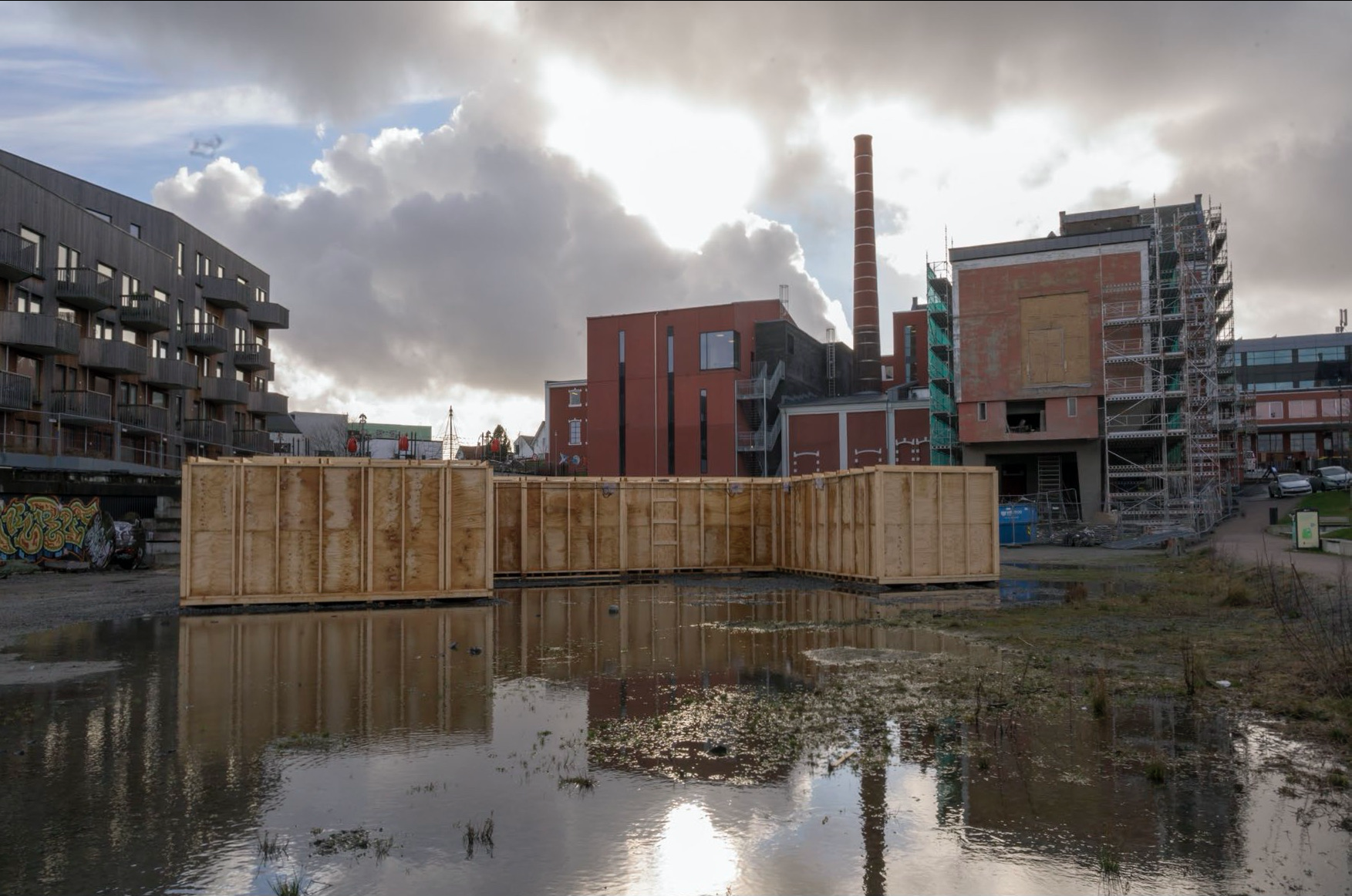Etterklang er ei form for ekko. Det er ein veikare klang som følgjer etter ein sterkare klang. 1
Det er lyd i eit rom som ikkje forsvinn brått, men snarare heng att. 2
Mange ekko i rask rekkefølgje, med avtakande intensitet. 3 Drag frå noko som var. Fenomenet etterklang kan tena som ei lydleg skildring av kunstprosjektet SKAUS. Men kor avtakande intensiteten blir i dette tilfellet, og når den startar å avta, står att å sjå.
- https://ordbok.uib.no/perl/ordbok.cgi?OPP=etterklang&ant_bokmaal=5&ant_nynorsk=5&begge=+&ordbok=begge
- Store norske leksikon, om etterklang, https://snl.no/etterklang (henta 26.01.2021)
- https://snl.no/etterklang
Den særeigne, virusplaga våren 2020 bretta det seg ut eit komplekst kunstprosjekt på to ulike lokasjonar i Stavanger. Ein bygningskropp reiste seg på tomta framfor Tou kulturhus i Østre bydel og ein annan bygningskropp inne i andre etasje på Rogaland Kunstsenter i Stavanger sentrum. Begge utforma i tre, og identiske i form og konstruksjon. Den eine ute i det fri, den andre inne i ein kunstinstitusjon. Førstnemnde på ei utviklingstomt, som på folkemunne vert kalla ventetomta, ja, fordi den er ventande, som så mange andre område rundt i ein by, ventande på ei avklaring av kva den skal nyttast til. Ventetomta i Østre bydel ligg tett på sjøen, skvisa mellom ei rekkje nyreiste bustadkompleks, ein park og den gamle ølfabrikken som er blitt kulturhus. Eit område som har vore gjennom ein ganske standard gentrifiseringsprosess altså, ei utbygging og vakraregjering av eit tidlegare nedslite industrielt byområde. Ventetomta, som er i privat eige, ventar på svar om den skal bli grunn for nok eit bustadkompleks eller om den skal få bli noko anna. Eit grøntområde til dømes, eller eit aktivitetsområde. Eit område der ålmenta kan opphalda seg og møtast.
Den andre bygningskroppen opererte langt frå i det fri, den var snarare pressa inn i gallerirommet i andre etasje på Rogaland Kunstsenter. Begge bygningskroppane var utforma som replika av romløysinga og volumet til dette rommet på kunstsenteret. Då bygningskroppen vart oppført inne på kunstsenteret tok den då òg bortimot heile gallerirommet, berre ein smal passasje på ein meter i breidda stod att på utsida. Passasjegangen var slik sett det einaste som var igjen av «det vanlege rommet» andre etasje på kunstsenteret utgjer. Brått bestod rommet av nye veggar, nye skiljelinjer, og dermed òg nye rom. Sidan utsida av bygningskroppen framleis var innsida av Rogaland kunstsenter, fann ein seg sjølv, i denne passasjen, både på utsida og innsida samstundes.
SKAUS VERSJON STAVANGER
Det komplekse kunstprosjektet har namnet SKAUS og er eit samarbeid mellom kunstnarane Mari Kolbeinson, Håvard Sagen og Markus Bråten. Det var pilotversjonen av prosjektet som vart testa ut i Stavanger i 2020. Gjennom pilotprosjektet si levetid frå februar til september 2020 vart i alt ni kunstnarar invitert til å stilla ut i dei to bygningskroppane. Prosjektet var delt inn i fire fasar, og ein kunstnar stilte ut i ein bygningskropp i kvar av fasane (fordi ein duo deltok på ein av desse ende det opp i totalt ni involverte kunstnarar). Kunstnar Apichaya Wanthiang var sparrepartnar for trioen, og bidrog mellom anna med å spissa og forma det konseptuelle byggverket i tidlege fasar av prosjektet, samt føra dialog om koplingar mellom dei konseptuelle og dei fysiske strukturane.
Kolbeinson, Sagen og Bråten er initiativtakarane bak prosjektet. Dei har laga rammene for det og har invitert kunstnarane som har stilt ut. Forstått på denne måten har dei kuratert prosjektet, men heller ikkje meir enn nett litt. Etter invitasjon og tildeling av bygningskropp var tilnærminga deira heller bevisst ukuratert. Kuratert ukuratert om ein vil. Rammene for dei inviterte kunstnarane var at dei kunne gjera kva dei ville. Korleis dei ville. Med dei materiala dei ville. På og i bygningskroppen. Men produksjonen måtte skje innan ein periode på tre veker. Og kvar kunstnar sin produksjon og si utstilling skulle stå att i bygningskroppen, slik at neste kunstnar, om hen ville, kunne arbeida vidare med og frå den førre sin produksjon.
Kolbeinson, Sagen og Bråten ser på SKAUS som ein plattform for utforsking. I sitt statement kunngjer den trehovuda personaen at SKAUS både er vertskap og okkupant, og at plattforma bidrar med støttestrukturar – både fysiske og andre – til utforsking av møter mellom stader, kunstnarar, institusjonar, sosiale infrastrukturar og publikum. Prosjektet har slik mange fasettar. Det er strekt ut i tid og rom gjennom sin fleirfasa form. Aktørane er mange, og dei ulike aktørane har varierte rollar til forskjellige tider. Dei er okkupantar, mottakarar og samarbeidspartar. Kunstnartrioen bak SKAUS er både (hovud)okkupant, dei er vertskap, men dei er òg ei samarbeidande kuratorgruppe som har lent seg tilbake. Etter dei har definert lokasjonar, invitert personar og bistått med naudsynte infrastrukturar, har dei sett seg sjølv på sidelinja, gjort seg sjølv til tilskodarar, som følgjer med på utviklinga, frå ei slags utside. Kunstprosjektet rommar slik ei rekkje formar for samarbeid, og er fleirfasa, fleirrolla og fleirstemt. Men kva kunstverk og hendingar var det så som manifesterte seg, og kva tema vart undersøkt gjennom utstillingane? Og er det i det heile teke mogleg å sjå ein heilskap i det utstrekte prosjektet?
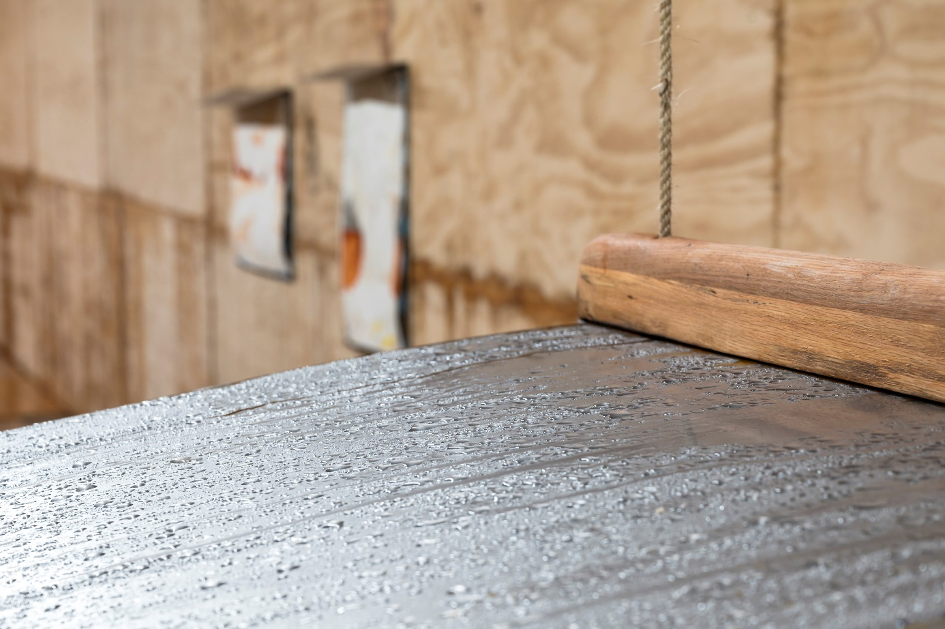
FASE 1-4
Prosjektet starta med ei innviing. Første utstillingsopning i februar 2020 bestod av ein introduksjon av dei to bygningskroppane. Dei to bygningskonstruksjonane, som på dette stadiet ikkje hadde nokre opningar, var Kolbeinson, Sagen og Bråten sine initierande skulpturar, eller verk, som publikum under innviinga fekk sjå og kjenna på utanfrå. Kunstnarane i fase 1 møtte bygningskroppane slik, som to lukka konstruksjonar, og det var opp til dei sjølv å bestemma korleis dei skulle koma på innsida. Om det var det dei ville. Ikkje utprega inviterande som startpunkt, men kanskje er det her tanken om den inviterte, men frie okkupasjonen ligg. Med dette startpunktet er det òg mogleg å tenkja seg at ein i løpet av prosjektet si levetid aldri ville ha kome på innsida av bygningskroppen. Dei to kunstnarane som var først ut, Andreas Amble og Linda Lamignan, lagde begge tradisjonelle døropningar inn i SKAUS-kroppen. Lamignan i tillegg ei rektangulær opning i augehøgd, som eit vindauge. Amble på ventetomta, Lamignan på kunstsenteret.
Ute i det fri finst som kjend naturen og naturelementa, og eit av desse gjorde mykje ut av seg i Amble sin fase. Svært mykje regn fall medan Amble si utstilling husa bygningskroppen. Slik sett var det ikkje berre Amble, men òg vatn, som okkuperte bygningskroppen på ventetomta i denne perioden. Ute kom inn. Amble bestemte med sin menneskelege agens at han og vatnet kunne okkupera i lag, spela på lag, skjønt bestemte og bestemte, med vatn sin sterke agens er det ikkje alltid mennesket har noko val. Val eller ei, så synast dette lurt kunstnarisk sett. Skulpturane Amble hadde sett ut i rommet, som bestod av mellom anna porselensvasar, maleri, små eikeskulpturar og omarbeidd metall, vart sett slik at regnet som søkte inn trefte desse. Krukker og kar og behaldarar vart fylt med vatn. Tok i mot vatn. Heldt varsamt rundt vatn. Vatnet lagde nye mønster i treveggane. Dynka eikeskulpturane. I tillegg aktiverte sjølve prosessen med regnfall og -inntrenging eit perkusjonsaktig lydspel. Amble si utstilling vart slik eit stadbasert verk som ønskte nye element velkommen inn, og der det besøkande elementet vart deltakar i utforminga av både enkeltverk og utstillinga i sin heilskap.
Linda Lamignan si utstilling var samstundes å sjå i bygningskroppen på kunstsenteret. Her var SKAUS-konstruksjonen tørr og trygg. Ubehandla. Finsleg samanlikna med ventetomta, allereie i fase 1. Lamignan produserte tre maleri i sterke fargar, malt med parafinvoks. Dei vart malt på trestykke frå bygningskonstruksjonen som Lamignan hadde fjerna. Eit maleri hang vis-a-vis feltet i veggen der trestykket var tatt vekk. Det vart ei luke å sjå inn frå. Var ein utanfor, i passasjegangen mellom bygningskroppen si utside og ytterveggane til kunstsenteret, kunne ein kikka rett på maleriet. Eit anna maleri låg på golvet på ein rektangulær opphøying i tre. I tillegg låg det ein haug med parafinvoks i eit hjørne på golvet. Restar av produksjonen. Lamignan gjorde òg SKAUS-kroppen si innside til eit relativt tradisjonelt visingsrom, og på innsida vart det vist få, men fargesterke maleri.
Dette var fase 1.
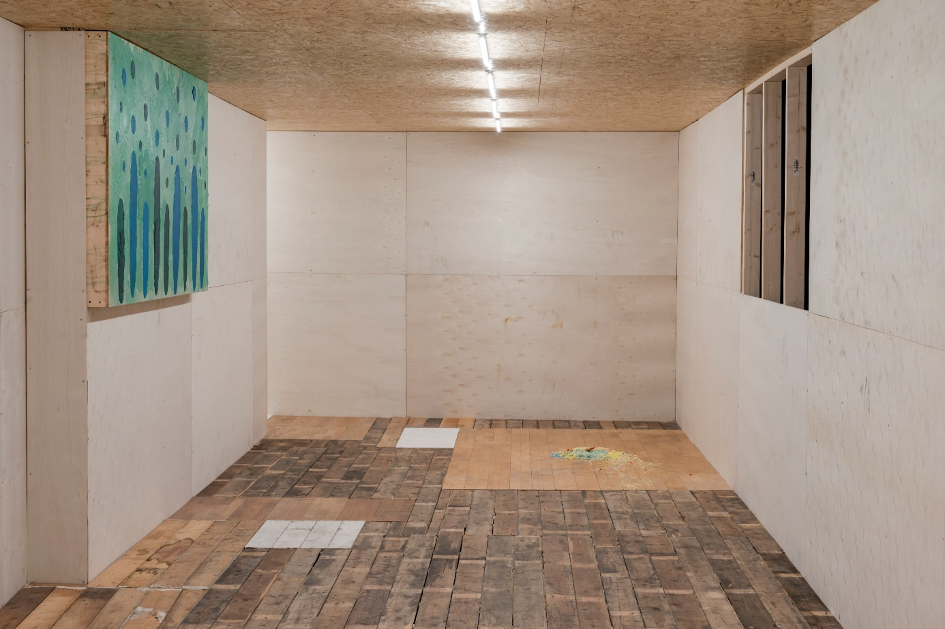
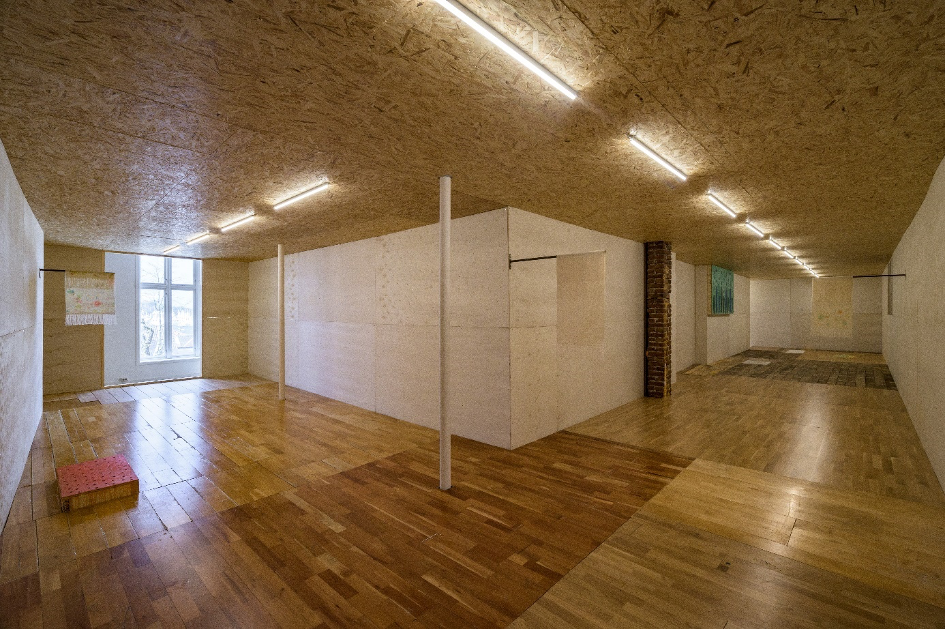
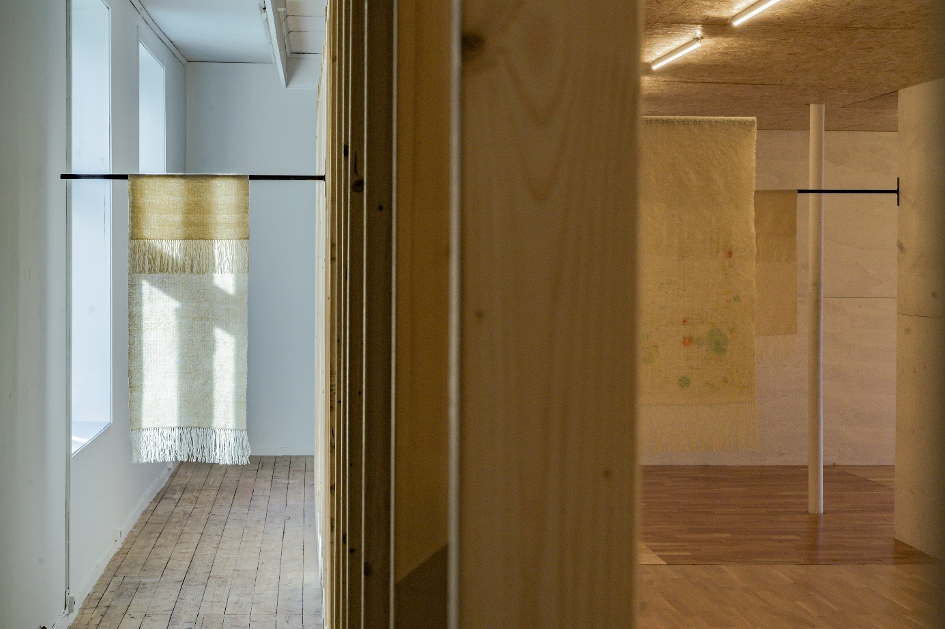
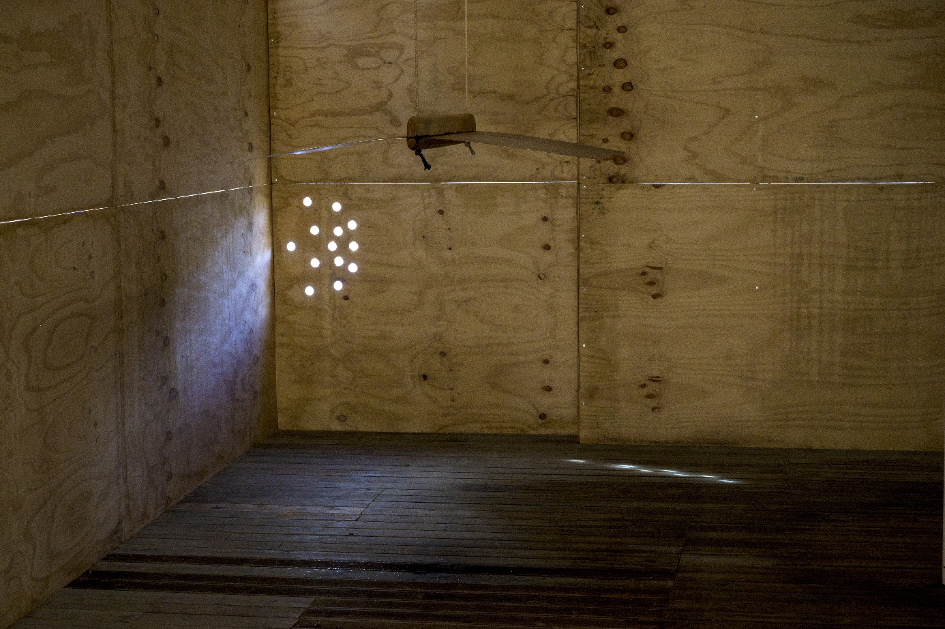
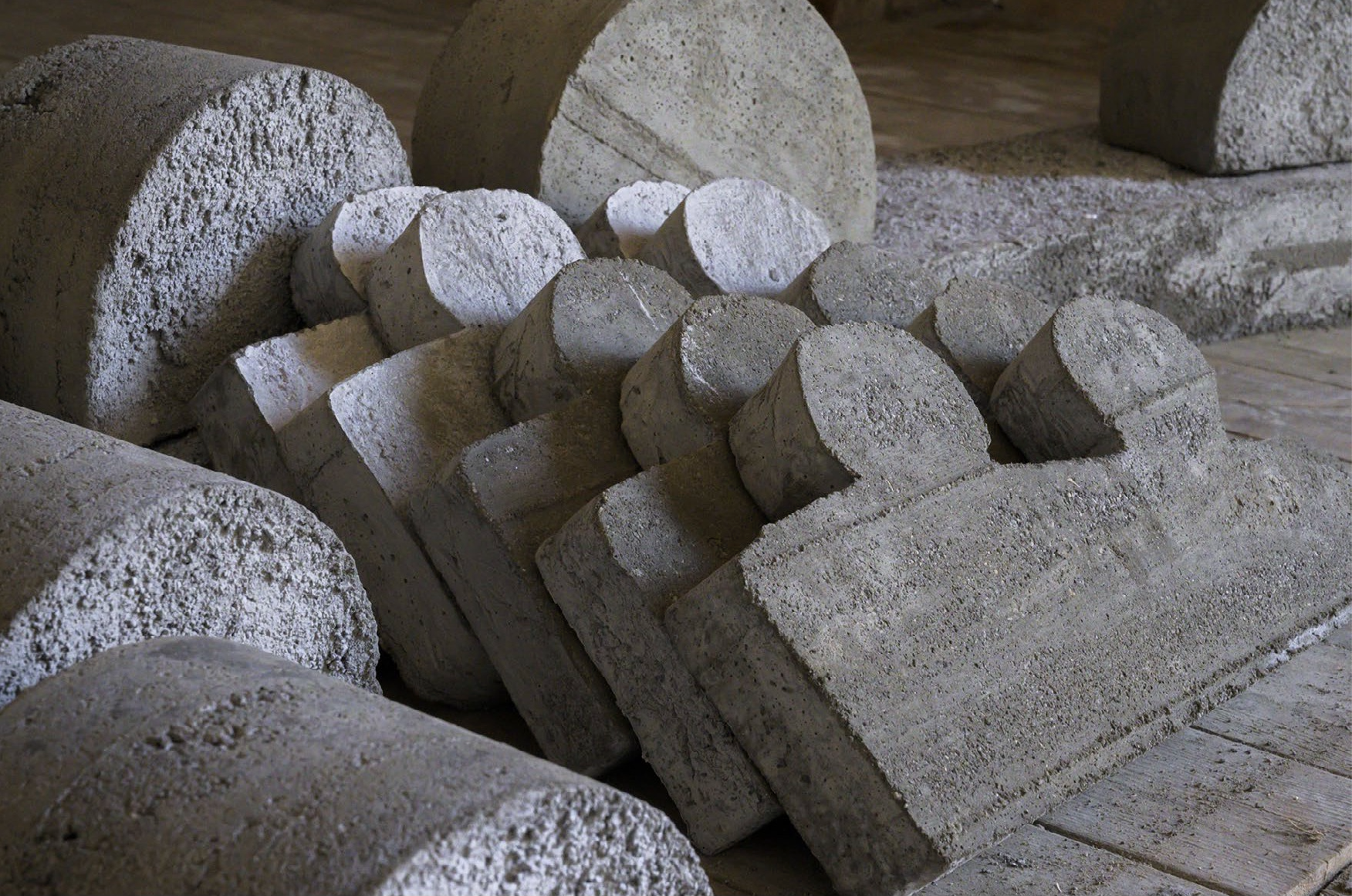
Ingeborg Kvame tok over etter Lamignan på kunstsenteret. Kvame vevde tekstilstykke som ho hengde både på innsida og utsida av bygningskroppen. Dei lystona tekstilane hang frå metallrøyr ut frå veggen. Kvame lot Lamignan sine maleri vera att. Parafinvoksen låg att. Kvame nytta òg noko av parafinvoksen til å setja små fargefelt på sine eigne tekstilstykke. Ho smelta voks inn i vevane sine. Kvame utforma slik utstillinga si i kompaniskap med den fråverande førre okkupanten, og nytta materialar frå Lamignan si utstilling til å forma sine eigne verk. Kvame si utstilling stod fram i etterklangen av Lamignan si. Verd å merka seg i så måte er at dei sarte fargetonane og det stillferdige nærværet til Kvame sine verk, ikkje tok merksemda frå, eller konkurrerte med, dei attverande verka til Lamignan. Kvame hang òg verk på utsida av bygningskroppen og aktiverte med dette mellomrommet mellom SKAUS-kroppen si utside og kunstsenteret sin yttervegg samstundes som ho utvida rommet etter Lamignan.
Innebygd i gestene til Kvame ligg ei ytring om at det er plass til fleire. Ein kunstnar treng ikkje flytta seg eller fjerna seg for å gi plass til andre kunstnarar. I tillegg understrekar gestene verdien av gjenbruk. Den materielle utforskinga til Kvame bringer til overflata at gjenbruk av både idear, materialar, inspirasjon og påverknad er ein sentral del av kunstnarisk produksjon. Ein kunstnarisk produksjon er ekko frå andre produksjonar.
Amble overleverte si utstilling på ventetomta til Ingrid Furre. Furre gjorde òg valet om å la Amble sine verk stå att. Furre opna fleire veggparti i bygningskroppen og slapp lys inn på metallobjekta til Amble. Opna for gjennomgangslys i bygningskroppen. Sola kom, veggar og golv tørka opp, og nok ei naturkraft og eit menneskeleg val gjorde til at skulpturar og verk stod fram på nye måtar. Furre sine omarbeidingar og sola sitt nærvær gjorde til at verka og bygningskroppen tidvis stod bada i eit skarpt skinande lysspel, nokre gonger i symmetri med verka, andre gonger i asymmetri. Furre lagde òg små hol i veggen på bygningskonstruksjonen, kikhol ein kunne sjå ut eller inn gjennom. Hola skapte nye bindingar mellom inne og ute, bidrog med luft, og gjorde til at objekta, kunsten, verda stod fram gjennom nye perspektiv – slik avgrensingar og innrammingar gjerne gjer. Kikhola vart òg som små poetiske lyskastarar, der dei kasta strimer av lys inn i bygningskroppen.
Furre hadde vidare laga sementstykke i ulike former som ho plasserte spreidd rundt inne i bygningskroppen. Nokre lent inntil kvarandre. Andre for seg sjølv. Kanskje kom ideen til materialval av at betong toler fukt, og fordi bygningskroppen var i ferd med å bli fukt, råte og vatn etter Amble sin regnfulle fase så trengte den noko handfast? Furre nytta både regnvatn og saltvatn i sementblandinga si, og utnytta slik det stadbaserte. Nokre av sementformene var forma som boger, som gjennom si plassering på golvet, gjorde til at ferdselsbanane til publikum i utstillinga endra seg. Bogene var òg, på tross av at dei var skapt i eit brutalt og hardt material, på sett og vis milde og inviterande. Om form var alt, så innbydde sementskulpturane til kvile og opphald. Om material var alt, var dei kalde blokkar som sat opp nye skilje i rommet. Vasane til Amble hadde Furre plassert fint inn mot veggen, medan metallobjekta stod att der dei hadde vore. Maleria til Amble hang Furre ut på utsida av bygningskroppen, mogleg for at dei skulle få tørka. Rørslene, endringane og produksjonane Furre aktiverte, gjorde hennar utstilling både til eit lysspel og til eit iaugefallande materialspel.
Dette var fase 2.
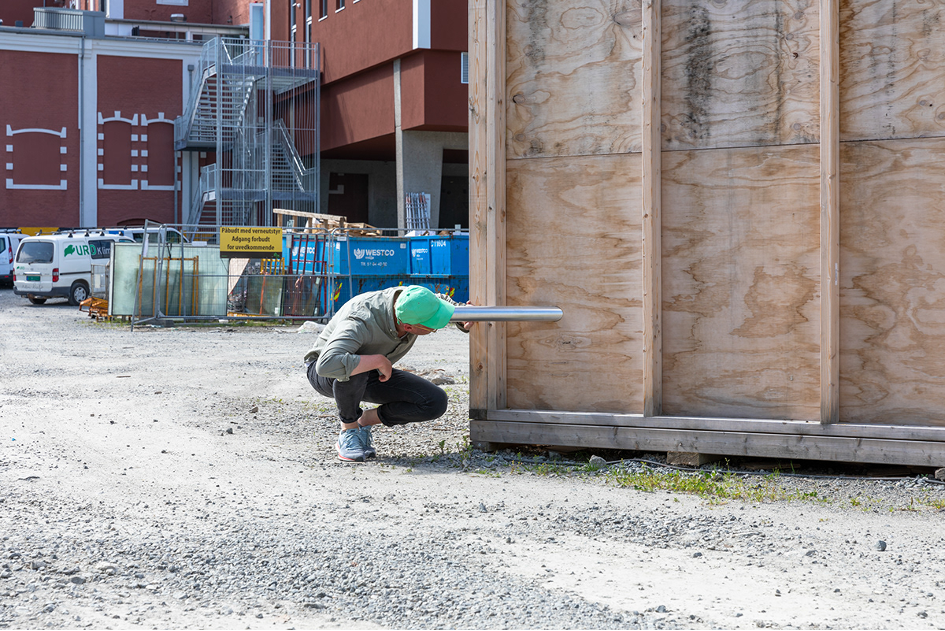
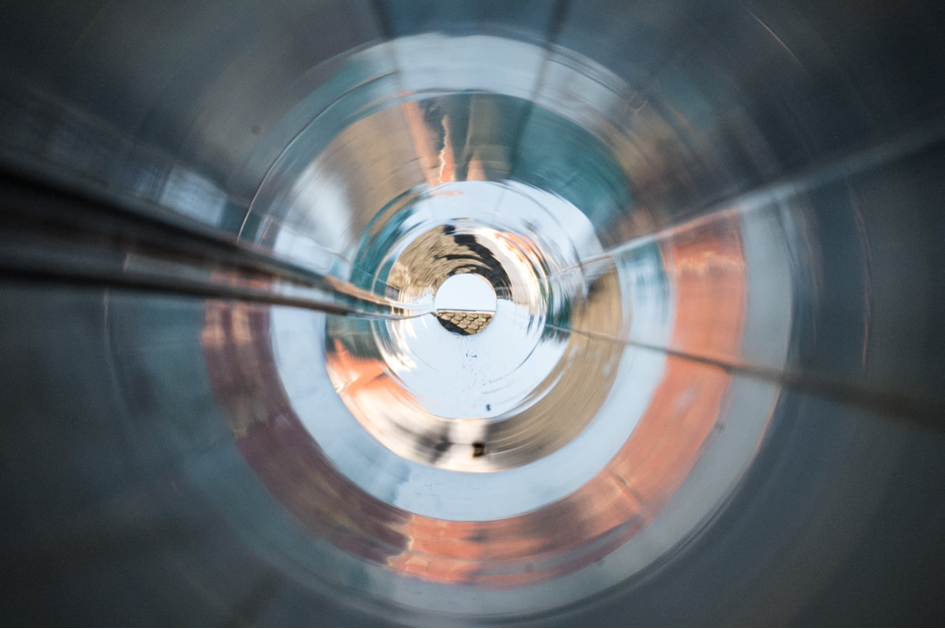
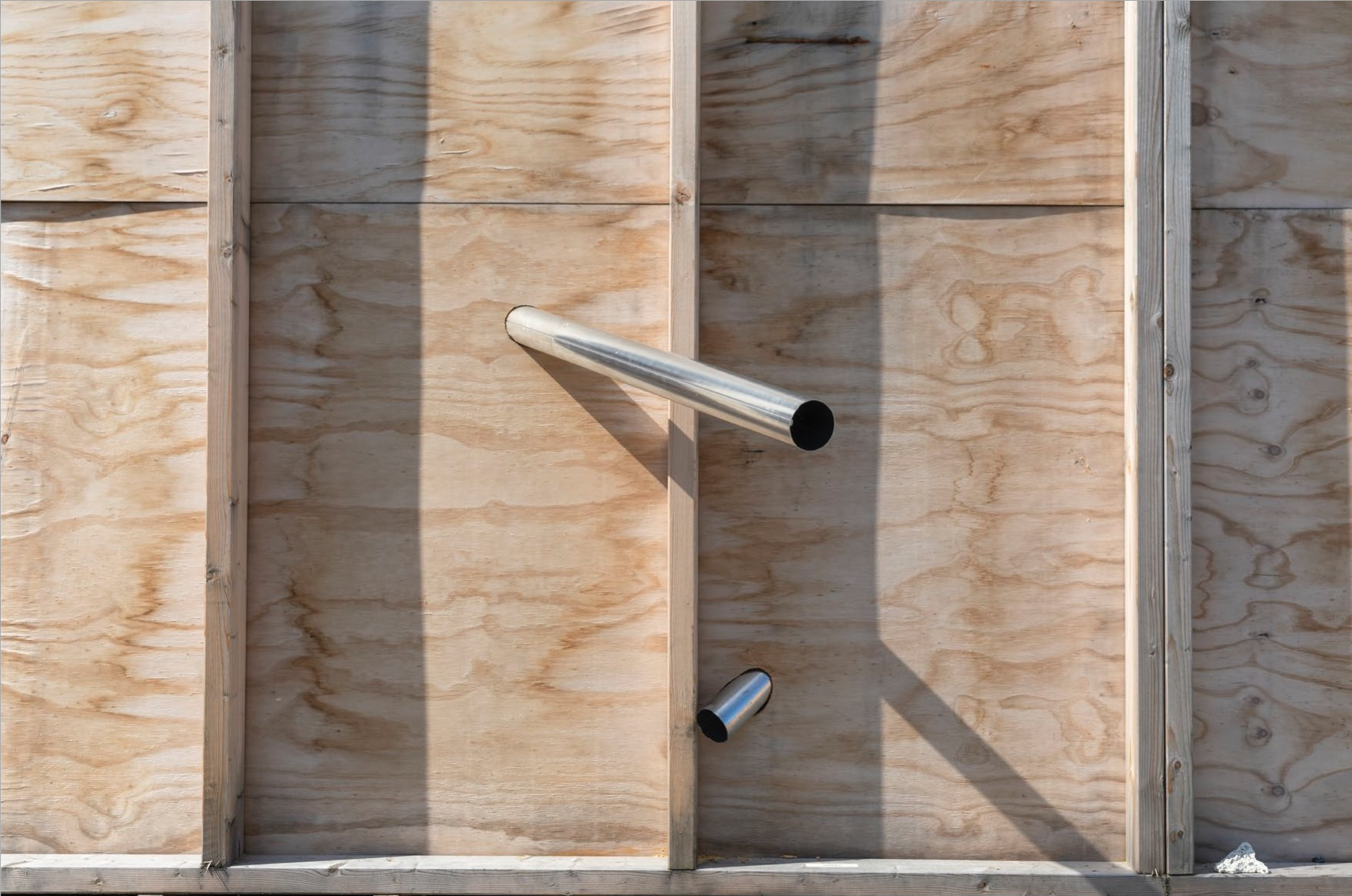
Edvine Larssen følgde Furre på ventetomta. Larssen stengde bygningskroppen med grunn i at tidlegare fasar hadde hatt stort fokus på bygningskroppen si innside. Ho vende blikket utover. Larssen installerte 6 røyr som gjekk gjennom konstruksjonen, og som slik skapte 12 særeigne perspektiv. Metallrøyra vende seg i ulike retningar, mot spesifikke punkt og objekt på utsida av bygningskroppen. Røyra styrte blikket mot spesifikke og mindre utsnitt av verda: mot sjøen, mot eit gjerde, ein grastust, eit tak, ei leilegheit. Når ein lente seg mot røyra, sjølv om ein kjende omgjevnadane frå før, kunne ein ikkje vita kva utsnitt eller motiv ein ville bli servert. Ein trudde ein skulle sjå inn, men vart styrt mot omgjevnadane. Larssen aktiverte med dette ei vending mot bygningskroppen si utside, den aktuelle staden, ventetomta og omgjevnadane sine eigenskapar. Utstillingsrommet i bygningskroppen vart delvis gjort usynleg, og konstruksjonen vart redusert til ein berar av røra. Ein berar av nye perspektiv. Einaste moglegheita til å sjå inn var gjennom to dørkikkertar Larssen hadde montert. Desse var retta mot enkelte av verka frå Amble og Furre.
Arbeidet til Larssen aktiverte både arkitektoniske grep og fotografikunsten, sistnemnde gjennom å styra og leika med perspektivering og synsvinklar. Slik skriv utstillinga hennar seg inn i interessa ho har vist for synsteknologi og synsvinklar i sin kunstnarskap – for det å skapa nye synsvinklar.
Héloïse Delègue var okkupanten som følgde Kvame på kunstsenteret. Ho valde å ta vekk Kvame og Lamignan sine verk, og malte nye maleri og kollasjar direkte på veggane på innsida av bygningskroppen. Hestar og bein som eit form for humoristisk gjennomgangsmotiv viste seg i lilla-, rosa- og gul-tonar. Nokre av dei likna pop up-figurar. Delègue fylte store delar av innsida av bygningskroppen med veggmalte verk, fargeflatar og kollasjar, og tok i plass og farge opp større delar av rommet enn dei to føregåande kunstnarane gjorde til saman. Her var ikkje noko gjenbruk eller delt forfattarskap, bortsett frå at ei tom ramme frå det største maleriet til Lamignan hang att. Her var ingen linjer frå Delègue si utstilling til dei to kunstnarane som stilte ut før ho. Delègue okkuperte eigenrådig rommet med sin eigen produksjon. Som eit avbrote ekko. Utstillinga til Delègue vart slik eit avbrote ekko som stoppa kontinuiteten av utvekslingar mellom kunstnarane. Og sjølv om både vidareføring og brot låg innanfor den sparsommelege kurateringa SKAUS opna for, hadde det etter mi meining vore meir interessant om utstillingane heldt fram med å kommunisera seg imellom. Utstillinga til Delègue kunne like gjerne vore i kunstsenteret sitt vanlege rom, og SKAUS-koplinga låg på sett og vis ubrukt.
Dette var fase 3.
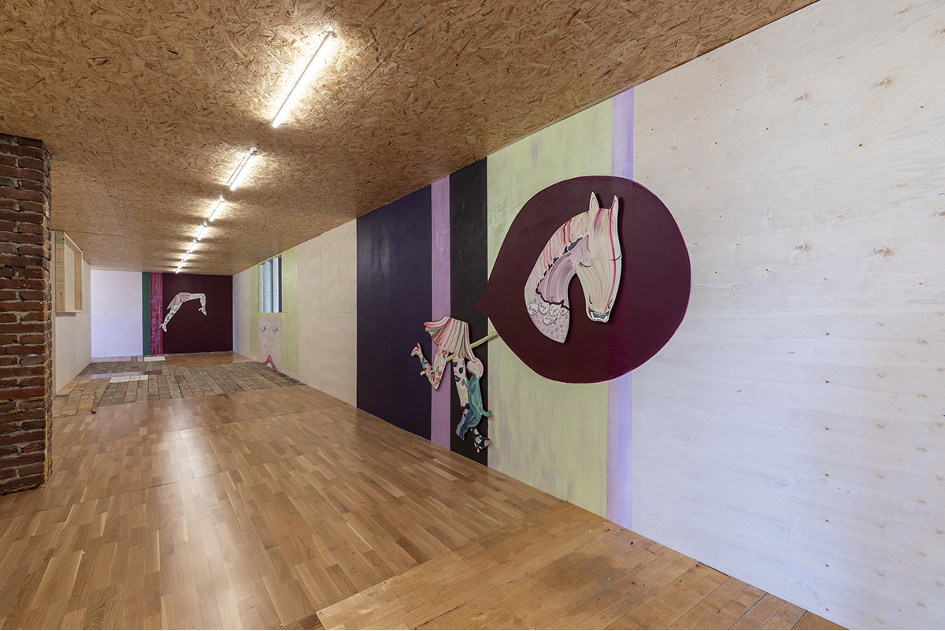
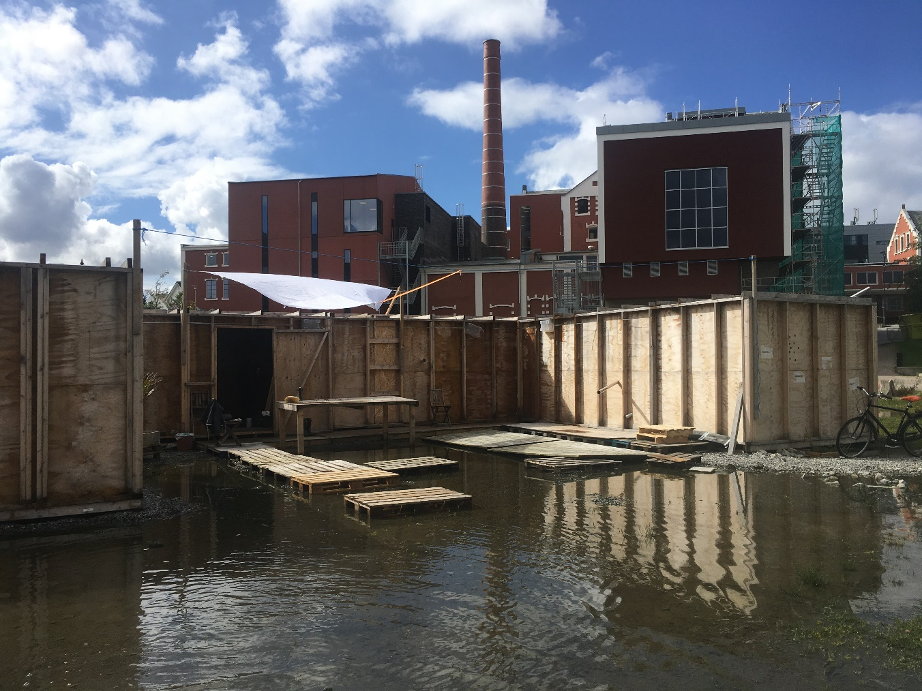
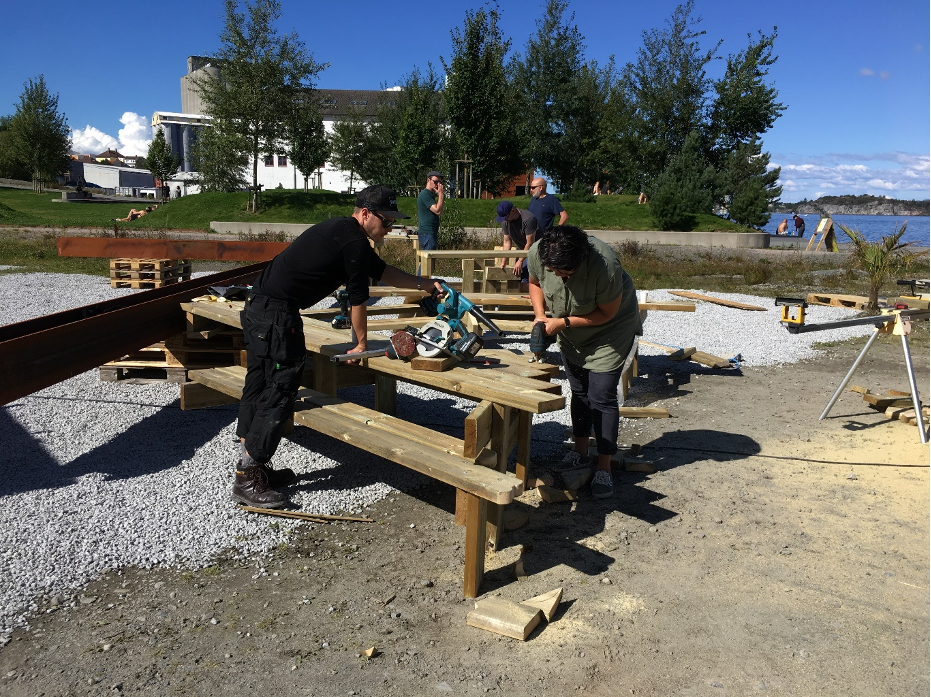
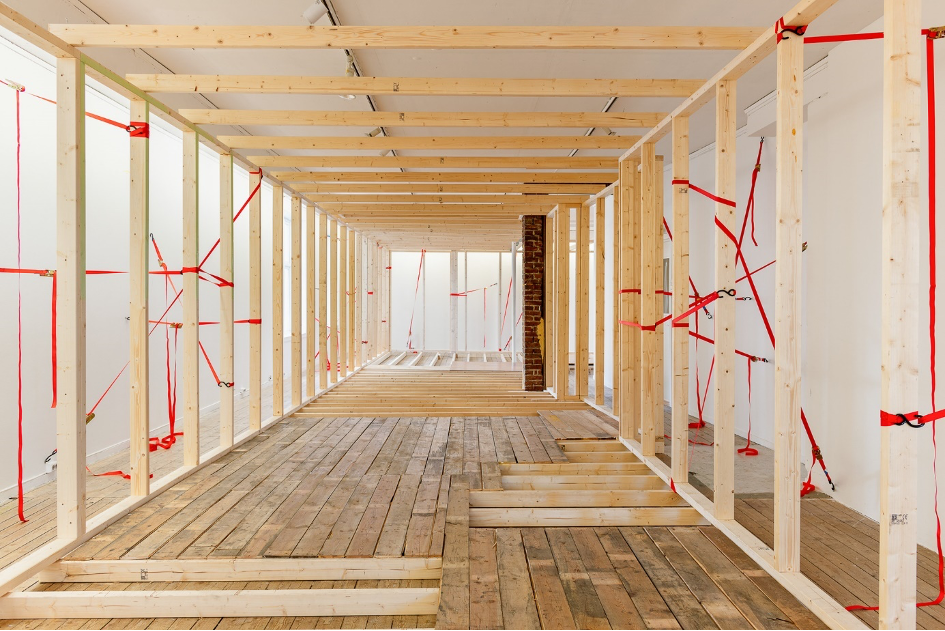
I siste fase var det Byverksted som okkuperte bygningskroppen på ventetomta. Byverksted er eit laust organisert, kunstnarisk orientert byutviklingsinitiativ, - med grafikar, aktivist og innbyggar Benjamin Hickethier i eit flatstrukturert, organisatorisk førarsete. Ein aktivistisk kropp eller tilslutning folk. Byverksted dukkar opp rundt omkring i Stavanger ved høve og behov. Overordna sett så utforskar verkstaden spørsmål om korleis ein verkstad for utvikling av byen (ein by) kan sjå ut, kven som vil vera med og korleis dette kan gå føre seg. Her er eit gjennomgåande engasjement for korleis byutviklingsprosessar kan bli meir demokratiske og nedanfrå-groande.
I perioden Byverksted husa SKAUS-kroppen på ventetomta vart rommet i og rundt bygningskroppen nytta til å vidareutforska og eksperimentera med byutviklingsengasjementet. Gjennom involvering og dialog med ei rekkje aktørar og institusjonar reiste Byverksted på SKAUS spørsmål om det er nok eit bustadkompleks innbyggarane og kommunen ønskjer på ventetomta på Tou, eller om det skal få gro fram andre initiativ, og i så fall kva for nokre. I kompaniskap med ulike personar vart det arrangert "seed-bomb" verkstad, tradisjonell byvandring, "critical mass" sykkeltur, opplesingar og foredrag, bygging av ein 50 meter lang grill (der ein kunne halda meteren) under namnet Kjærleik og pølser i koronaens tid, og mykje anna. Svært skiftande vær vart òg ein markant del av SKAUS sin fase fire (trass i at fasen gjekk føre seg i august), og tvinga byverkstaden innomhus og utomhus ei rekkje gonger i løpet av dei tre vekene verkstaden gjekk føre seg. Tidvis ga regnvatnmengdene inntrykk av at bygningskroppen var sjøsett.
Ut av siste fase på ventetomta kom ein trevekers gruppeseanse foreint om å skapa byrom, å skapa kunstrom, i fellesskap. Det vart ikkje skapt utstillingar i tradisjonell tyding, men ei rad hendingar. Verka til dei to føregåande kunstnarane stod att i bygningskroppen, men vart ikkje reaktivert eller gitt nye tydingar. Byverksted var særs stadspesifikk i si tilnærming på ventetomta, men gjorde i format moglegvis det same som dei ville gjort uavhengig av SKAUS.
På kunstsenteret var det Martinka Bobrikova & Oscar de Carmen som fekk avslutta. Dei gjorde radikale dekonstruksjonsgrep med bygningskroppen, dekonstruksjonar av typen som i alle fall eg hadde venta meg tidlegare, når først regelen var at alt var lov. Sjølv om øydelegging og dekonstruksjon av bygningskroppen i tidlege fasar unekteleg ville gjera mottakarrolla meir utfordrande, så hadde eg forventningar om at med heilt opne rammer var det fleire som ville kjenna drivet etter markante endringar og radikal nedriving. Bobrikova og Carmen tok vekk veggar og tak i bygningskroppen, og synleggjorde med dette dei attverande strukturane. Festeband haldt restane av konstruksjonen oppe, no ankra til veggen til kunstsenteret. Passasjen på utsida av SKAUS-kroppen var slik ikkje lenger tilgjengeleg. Bobrikova og Carmen si utstilling var på denne måten ei ytring i institusjonskritisk ånd, ein kommentar til at prosjektet SKAUS – sjølv om det har mål om å gi meir makt til kunstnarane – òg er «tied to a complex institutional framework that served as an umbrella for its birth». 4 Ekkoet som drønna frå utstillinga til kunstnarduoen Bobrikova og Carmen var at SKAUS er skapt innanfor ei ytre ramme av institusjonelt nærvær. Kunstnarduoen både opna rommet gjennom å sprenga nokre materielle grenser, men lukka det på sett og vis igjen, synleggjort av det tette institusjonelle nærværet. SKAUS-kroppen og institusjonen blei ein. Kunstnarduoen slapp luft inn i bygningskroppen, men det var ei institusjonell luft. Utstillinga vart eit sjølvrefererande ekko.
Dette var fase 4.
- Utstillingstekst Bobrikova og Carmen, https://bobrikovadecarmen.org/texts/dysfunctional-deconstructions-2/
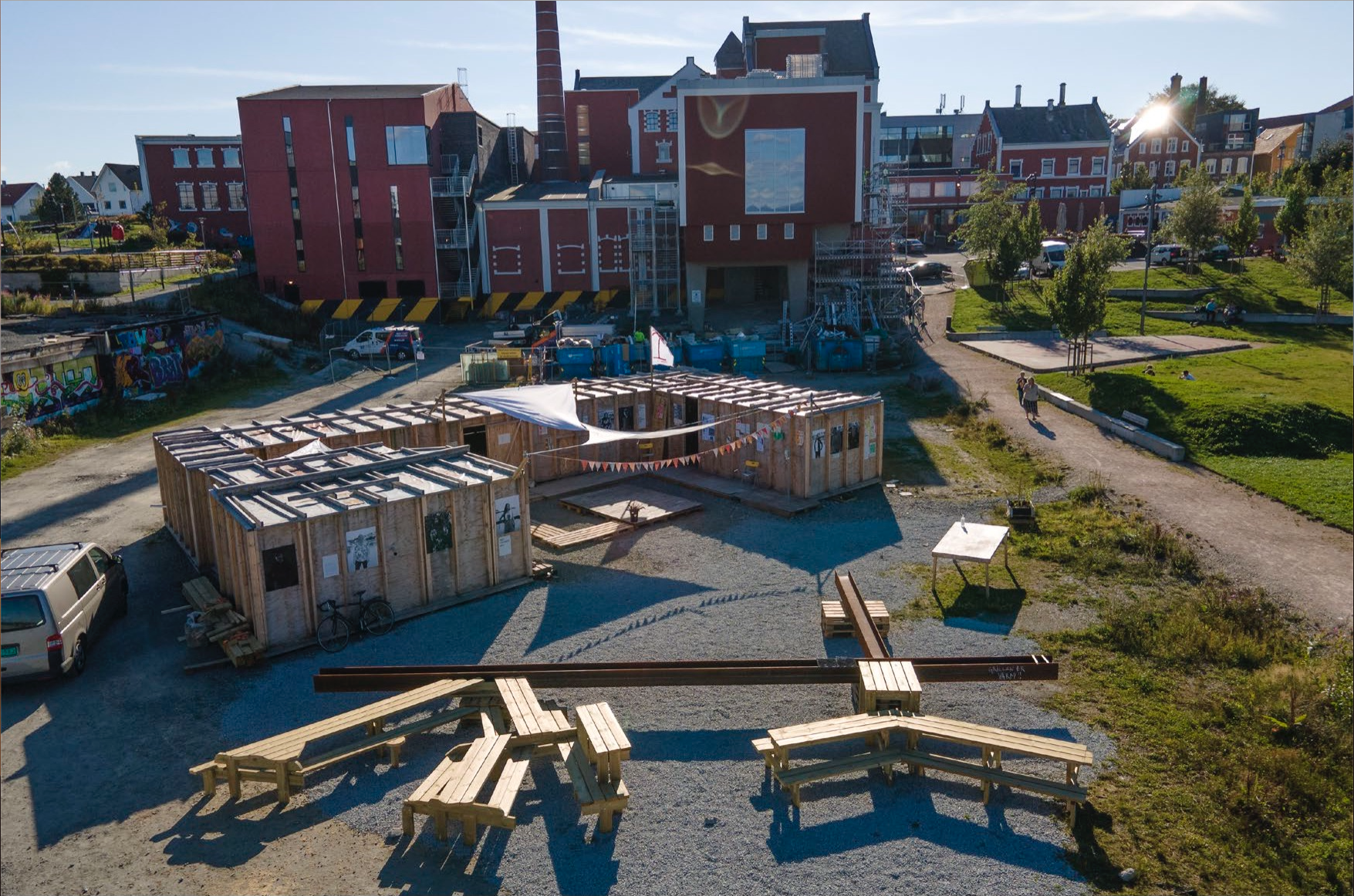
Sidan tid er relativt kan ein sjå fasane som ekko i tett rekkefølgje. Kunstnarane både utvida og perspektiverte, gjenbrukte og avslutta, førte dialog med materialar, førte dialog med folk, spelte på lag med naturen, løfta fram kunstnariske og politiske ytringar, og leikte med form. Nokre i etterklangen frå dei som hadde vore før, andre braut opp ekkoet eller stilte spørsmål ved det.
I etterklangen frå dei som hadde vore før dei.
Kunstprosjektet SKAUS vil vera, og er, det motsette av einsidig. Prosjektet er i sin heilskap ei understreking av mange både/og. Det er eit prosjekt og fleire prosjekt. I både tid og rom. Ute og inne. Innanfor og utanfor. Temporært og endelaust. Kuratert og ikkje kuratert. Flyktig og bestandig. Gjennom denne fleirstemtheita - som kanskje er den som utgjer heilskapen i prosjektet – løftar prosjektet fram ei rekkje kunstnarisk interessante spørsmål. Nokre av dei vil eg røra borti no.
GJENBRUK, OMBRUK, FLEIRBRUK
Gjenbruk, ombruk og fleirbruk er tema som ligg innbakt i SKAUS-prosjektet. I sjølve innrettinga, og ikkje minst i fasestrukturen, ligg ytringar om at objekt kan gis fleire liv. Koma tilbake som noko anna. Brukast til fleire ting. Vera fleire ting. Til dømes hadde SKAUS-personaen tenkt å bruka trematerialet frå bygningskroppane til å laga seg ei flåte, som dei skulle reisa ut i verda med. Kan hende skjer det, kan hende ikkje. Materialet frå SKAUS versjon Stavanger ligg uansett i skrivande stund på lager, og skal mest sannsynleg bli med SKAUS vidare ut av landet, i ei eller anna form. Mange av kunstverka ligg òg att på det same lageret. Dei kan brukast igjen. Tas med vidare. Oppstå som noko anna. Bli eit drag frå noko som var.
I ein googlerunde i samband med at eg skriv om Lamignan si utstilling, forvillar eg meg inn på finn.no, til ei annonse der nokon sel parafinvoks. 5 Vedkomande som sel reklamerer med at parafinvoks har eit uavgrensa bruksområde. Eg tenkjer det er ei vel overivrig salssetning fordi det strengt tatt er lett å koma på mykje parafinvoks ikkje kan nyttast til, men eg blir likevel hengande fast i annonsen og bodskapen i den. Rein, høgraffinert parafinvoks til mange bruksområde, skriv hen, og nemner støyping av lys, produksjon av tennbrikettar, metting av endeved på tømmer, skivoks, som botemiddel for knirk i tregolv, som slipemiddel på snøplog, snøfresar og snøskuffe. Dette er ikkje mitt kompetanseområde, så etter å ha sett for meg dei konkrete objekta som vert nemnd, og registrert at det trass salssetninga må seiast å vera eit breitt tilfang av bruksområde, går tankane vidare til bruk og gjenbruk meir generelt. Eg kjenner ikkje grunnane til at Lamignan brukte parafinvoks i maleriproduksjonen sin, men materialet er unekteleg «skausk». Og: Kva ville det ikkje innebera for overforbruk og dei materielle omgjevnadane våre om fleire objekt hadde eigenskapane til denne parafinvoksen? Om fleire objekt hadde denne fleirbrukskvaliteten? Gjennom fokuset på og interessa for gjenbruk, ombruk og fleirbruk har SKAUS-prosjektet i seg ein kritikk mot den trass alt galopperande kapitalismen som pregar samtida vår, og tilbyr eit rom der alternativ til denne kan få utforska og utfalda seg i det små.
- https://www.finn.no/bap/forsale/ad.html?finnkode=66421536
INSTITUSJONELL DISKUSJON
Eit anna tema er den innebygde kimen til institusjonell kritikk som ligg i den sparsommelege kurateringa. Dei to identisk utforma bygningskroppane, skapt ut av forma på gallerirommet på Rogaland kunstsenter, men plassert på to ulike lokasjonar, retta merksemda mot kva som er på innsida og utsida av kunstinstitusjonen med stor K. Likskapar og forskjellar mellom innsida og utsida av kunstfeltet. Ein bit av kunstsenteret reiste seg på ventetomta. Kunstinstitusjonen drog på ferd i det fri. Gesten kan takast til inntekt for ønskjer om at Kunstinstitusjonen oftare burde vandra utanfor sine eigne rammer. I alle fall kan den takast til inntekt for eit ønskje om å diskutera kva som kan skje når den gjer det.
Og kva var det som skjedde når det gjorde det? Ikkje mange av kunstnarane greip denne kimen. Bobrikova og Carmen gjorde det eksplisitt. Deira utstilling vart ein sjølvrefererande kommentar til at okkupasjonen trass alt gjekk føre seg innanfor institusjonelle rammer. Rogaland kunstsenter, som her representerer Kunstinstitusjonen, bærer i siste fase SKAUS-kroppen. Ein kan seia at SKAUS-personaen sjølv legg rammer for prosjektet som liknar institusjonars framferd, sjølv om dei søkjer å gjera rammene så opne som råd. Slik koplar dei seg på tendensane til at institusjonskritikk i kunstfeltet er internalisert, at den i stor grad vert uttrykt innanfrå, og at eit snev av sjølvpålagt institusjonskritikk er forventa både frå institusjonane sjølv og frå andre aktørar i kunstfeltet. 6 Institusjonskritikk er og har lenge vore ein pågåande samtale, som må ein vel innrømma, er kjenneteikna av ein noko uviss både adressat og effekt. I Bobrikova og Carmen sitt tilfelle var kritikken som vart fremja òg meir ein sjølvrefererande kommentar, enn det var reell kritikk. Kanskje er i så måte «institusjonsdiskusjon» eit meir fruktbart omgrep enn institusjonskritikk.
Samstundes med Bobrikova og Carmen si utstilling, vart Byverksted arrangert på ventetomta, i eit langt friare format. Dei to underprosjekta som utgjorde fase 4 kommuniserte ikkje direkte med kvarandre, men om rommet lukka seg med tett institusjonell luft på kunstsenteret i siste fase, så opna den seg på ventetomta. Over Byverkstaden på ventetomta var himmelen, ikkje institusjonell takhøgd. På ventetomta var det òg langt lettare å velta utover sine breidder enn inne i høgda på kunstsenteret. Bygningskroppen på ventetomta vart utbygd, fekk tentaklar i form av plassbygde benkar rundt seg, vind- og solsegl over inngangspartiet, strakk seg ut i diverse arrangement i nabolaget, og aktiverte folk som ikkje først og fremst bur i kunstfeltet. Involvering til engasjement og deltaking som på sett og vis var det motsette av sjølvrefererande ekko. Som var forsøk på å setja i gong varige samtalar, og på å vidareutvikla byen i fellesskap nedanfrå. Likevel, innan ei større ramme kan desse grepa òg tolkast som ein form for institusjonskritikk eller -diskusjon, men som i så måte i tillegg rettar seg mot «institusjonen» innbyggarinvolvering i politiske prosessar og mot demokratiske spelereglar og handlerom. Plassert i møtepunktet mellom kunst og byutvikling, rettar den institusjonelle diskusjonen seg slik både mot kunstfeltet og mot politisk-byråkratiske styringsprosessar.
Eit paradoks SKAUS-prosjektet synleggjer er difor at fri utfalding òg føreset rammer, sjølv om det i seg sjølv er ei sjølvmotseiing. SKAUS lagde fysiske og konseptuelle støttestrukturar og rammer som skulle gi mest mogleg makt til kunstnarane, men sjølv om dei la opp til så ukuratert kuratering som råd, har tilnærminga deira likevel institusjonsliknande trekk. Slik mimar prosjektet kunstfeltets institusjonskritikk, men frå ein fristilt ståstad.
- Sjå til dømes Kunst som deling, delingens kunst, 2020. Jonvik, Merete; Røssaak, Eivind; Stien, Hanne Hammer; Sunnanå, Arnhild, Fagbokforlaget, og Urettferdighet som prinsipp, 2020, Geir Haraldseth, i Billedkunst Nr. 4.
SAMPRODUKSJON OG DELT FORFATTARSKAP
Intensjonen med SKAUS er å tilby ein utforskande plattform, gjennom å la ei rekkje involverte aktørar undersøkja samarbeid, delt forfattarskap og forskjellige påbegynte forteljingar. Både enkeltverka, utstillingane og produksjonen i SKAUS er skapt gjennom delte forfattarskap og samproduksjon. Både planlagt og spontan samproduksjon, mellom kunstnarar, mellom kunstnarar og besøkande menneske og besøkande naturelement. Mellom kunstnarar og bygningskroppane og stadene. Den sosiale samproduksjonen bestod i at kunstnarar, som ikkje kjende kvarandre, ei heller sjølv hadde blitt einige om å samarbeida, utforma felles utstillingar. Brukte element frå kvarandre. Haldt fram der den andre hadde stoppa. Samproduksjonen med naturen tok form som at element som regnvatn, sol, lys og luft, både kravde sin plass og vart invitert inn som deltakar i kunstproduksjonen og -formidlinga.
Samproduksjon reiser spørsmål om opphav. Kven skal til dømes titulerast for utstillinga på ventetomta som stod i Furre sin periode? Furre? Furre og Amble? SKAUS? Likedan med regnet, sola, været, og dei sosiale samspelarane som deltok? Er desse del av verka? Er ein verkstad ei utstilling? Kor går grensene for eit verk? Kor sluttar og byrjar idear?
Formatet til SKAUS er slik i seg sjølv med og illustrerer noko som stadig gis større plass i kunstfeltet, at ein kunstnarisk produksjon er eit utfall av involvering og aktivering av ein rekkje menneskelege og ikkje-menneskelege aktørar. Dels vart dette understreka i skrifts form av til dømes Howard Becker som ser kunstproduksjonsprosessar som kollektive handlingar, men som då avgrensar seg til å inkludera sosiale aktørar. 7 Eller av Bruno Latour, som understrekar rolla ikkje-menneskelege aktantar, så vel som den menneskelege agens, speler i kunst- og medieproduksjonar. 8 Latour opererer med ein såkalla flat ontologi som anerkjenner rollene til det vellet av menneskelege og ikkje-menneskelege påverknadar, inspirasjonskjelder, strukturar, hjelparar, materialar, etc. som er til stades i (kunst)produksjon.
Frå den kunstnariske sida får fokuset sitt utslag i at andre og moglege påverknadskjelder rundt (spesielt genierklærte) kunstnarskap vert undersøkt med nytt blikk. Til dømes som med det kjende pissoaret til Marcel Duchamp, eller R. Mutt, som det latar til ikkje «berre kom frå Duchamp», altså ikkje berre sprang ut av hans genialitet åleine, men faktisk var ein idé gitt han av kunstnar, baronesse og venninna Elsa von Freytag-Loringhoven. Presentert i tekstar som «The woman who really made Duchamp’s Fountain». 9 Døma med den eventuelle påverknaden Elsa von Freytag-Loringhoven hadde på «Fountain», eller for den del vatnet si inntrenging og delaktigheit i SKAUS, eller kjeda av påverknadar mellom kunstnarane i dei ulike fasane, er ei anerkjenning av multippel aktør- og aktantinvolvering i kunstproduksjon. Eit slags wabi-sabi for kunstproduksjonsprosessar.
Eg tenkjer at den egosentriske heltedyrkinga som har prega kunstfeltet historisk sett er både enkel å forstå, men samstundes merkeleg. Den har i praksis innebore ei storstilt usynleggjering av «alt anna» enn kunstnaren si involvering, og har openbart ført kollektive skapingsprosessar i skuggen. Fokuset har gitt lite merksemd til det motsette av å framheva enkeltindividet, lite merksemd til slik som delte prosessar, fleirsidigheit, melting in.
Og apropos melting in. SKAUS-prosjektet har fått sitt namn frå matretten skaus, kortform for lapskaus, men som òg kanskje rettar seg mot gryta maten vart laga i. Gryta som hadde ei sentral plassering over ildstaden i ein heim, og som ikkje vart tømt eller vaska mellom rettane som putra i ho. Det tyder at nye ingrediensar og teknikkar vart nytta, med eit antakeleg større og større historisk etterslep av smakar frå tidlegare rettar. Resultatet vart moglegvis ei slags endelaus hemmeleg krydderblanding som ingen kunne gi den eigentlege formularen for. Men som like fullt prega kvar rett.
Ei rad med kulinariske ekko.
Eit drag frå noko som var.
Truleg er denne endelause og ikkje fullt ut kjende krydderblandinga ein betre metafor for kunstproduksjon, enn det einsame geniet som pressar fram idear, på tross av heller enn på grunn av omverda si delaktigheit.
- Becker, Howard S. 2008. Art Worlds: 25th Anniversary edition, Updated and Expanded, University of California Press.
- Latour, Bruno. 2005.Resassembling the social: An Introduction to Actor-Network Theory. Oxford University Press.
- Sjå til dømes: https://www.spectator.co.uk/article/taking-the-pissoir# og https://www.independent.co.uk/arts-entertainment/art/features/was-marcel-duchamp-s-fountain-actually-created-long-forgotten-pioneering-feminist-10491953.html
Slik heng klangen att frå SKAUS versjon Stavanger i byrjinga av 2021. Nye rom vart skapt. Nye verk vart skapt. Så langt kom utforskinga av samarbeid, delt kunstnarskap og tilrettelegging for fridom og autonomi i kunstproduksjon i pilotversjonen av SKAUS. Kva vil skje når andre stader og kunstnarar vert aktivert? Når andre rom, veggar og strukturar vert sett saman på nye måtar? Kva ekko vil drønna?
Merete Jonvik er sosialantropolog og sosiolog. Ho har ein PhD. i sosiologi frå Universitetet i Stavanger (2015). Avhandlinga hennar, Folk om forskjellar mellom folk, er ei utforsking av korleis folk frå ulike samfunnslag oppfattar og kommuniserer sosiale og kulturelle forskjellar. Jonvik bur og jobbar i Stavanger, som førsteamanuensis i sosiologi ved Institutt for medie- og samfunnsfag ved Universitetet i Stavanger. Forskingsområda hennar er hovudsakeleg innanfor kunst- og kultursosiologi. Jonvik har saman med Eivind Røssaak, Hanne Hammer Stien og Arnhild Sunnanå gitt ut boka «Kunst som deling, delingens kunst» (Fagbokforlaget, 2020). Boka omhandlar samtidskunstfeltet i Noreg etter 2010. Gjennom eit utval kunstnariske og kuratoriske praksisar, i tillegg til kunstnariske formidlingsarbeid, vert nye samarbeidsformer, kunstnariske delingsformer, kunstnarrollar og bruk av ny teknologi i kunstsamanheng omtalt og analysert. Jonvik skriv sporadisk for Contemporary Art Stavanger (CAS).
A Remnant of What Was: About the art project SKAUS
In this essay, sociologist and anthropologist Merete Jonvik provides a description and critical reflection of the art project SKAUS. She focuses on topics such as re-use and multi-use, collaboration and co-production, the origin of ideas and shared authorship. This text was written in January-February 2021, during the height of the coronavirus pandemic in Norway, and when the Stavanger version of SKAUS was completed and the project was on its way to Malmö, New York and who knows where else…
Reverberation is a form of echo – a weaker sound that follows a stronger one. It is a sound in a room that does not disappear abruptly, but rather bounces around for a while – many echoes in rapid succession, with decreasing intensity. A remnant of what was. The phenomenon of reverberation can serve as a sonic metaphor for the art project SKAUS. But in this case, the timing and intensity of the decrease still remains to be seen.
In the peculiar, virus-plagued spring of 2020, a complex art project unfolded at two different locations in Stavanger. A bare-bones building was erected on site in front of the Tou Kulturhus in the Eastern district while the skeleton of another structure was built inside the second floor of Rogaland Kunstsenter in the center of the city. Both were designed and built in wood, and identical in shape and construction – one outside in the open air, the other inside an art institution. The former building was constructed on a development lot, popularly referred to as ‘the waiting lot’, because it is, like so many other areas around a city, waiting for a clarification of its purpose. The waiting lot in Østre bydel is close to the sea, squeezed between a number of newly built housing complexes, a park, and an old beer factory that has become a cultural centre. It is an area that has been through a fairly standard gentrification process, ie, the development and beautification of a previously dilapidated industrial urban area. The waiting lot, which is privately owned, is awaiting an answer as to whether it will be the foundation for another housing complex or whether it will be allowed to become something else. An urban park, for example, or an activity area for the community, an area where the general public can meet one another and spend time outdoors.
Rather than operating in the open air, the second structure was pushed into the second floor gallery of Rogaland Kunstsenter. The framework for both buildings was designed as a slightly smaller replica of the dimensions and volume of the Kunstsenter’s gallery. When the body of the building was erected inside the Kunstsenter, it nearly filled the entire gallery space, leaving only a narrow, one meter-wide passage on the outside. The corridor was thus the only thing left of the “original gallery” on the second floor of the Kunstsenter. The interior suddenly consisted of new walls, new dividing lines, and thus also new rooms. Since the outside of this new building was itself still inside the Kunstsenter, when standing in the tight passageway, one found oneself simultaneously inside and outside.
SKAUS VERSION STAVANGER
The complex art project described above is called SKAUS. It is a collaboration between the artists Mari Kolbeinson, Håvard Sagen and Markus Bråten. The pilot version of the project was tested in Stavanger in 2020, and through the initial project’s lifespan from February – September 2020, a total of nine artists were invited to exhibit within the bodies of the two buildings. The project was divided into four phases, with one artist exhibiting in each structure during each phase (one of the participants was an artistic duo, totaling nine artists involved in the project overall). Artist Apichaya Wanthiang was a sparring partner for the initiating trio of artists, and helped to sharpen and shape the conceptual structure in the early phase of the project, as well as conduct a dialogue about the connection between conceptual and physical structures.
Kolbeinson, Sagen and Bråten created the framework for the project and were responsible for inviting the exhibiting artists. Seen from this perspective, they curated the project – but only very slightly. Apart from the invitation and allocation of the exhibition space, their approach was rather deliberately unqualified. “De-curated” if you like. The framework given to the invited artists was that they could do whatever they wanted – Korleis dei ville – with the materials they wanted, wherever they wanted on and in the building structures. However there were limitations. Production had to take place within a period of three weeks, and each artist’s production and exhibition should be left in the exhibition space, so that the next artist, if they wanted to, could continue working with and from the previous artist’s production.
Kolbeinson, Sagen and Bråten see SKAUS as a platform for exploration. In their press statement, the three announced that SKAUS plays both host and occupier, and that the platform contributes support structures – both physical and otherwise – to explore meetings between cities, artists, institutions, social infrastructures and the general public. The project has so many facets. It is stretched in time and space through its multi-phased form. The participants are many, and the different actors have varied roles at any given time. The three artists behind SKAUS are occupiers and hosts, recipients and partners, but they are also a collaborating group of curators who have taken a step back. After defining the locations, inviting artists and assisting with the necessary infrastructure, they have purposefully placed themselves on the sidelines, contributors who follow developments in the project from the outside. The art project thus contains a variety of unique collaborative forms, and is multi-phased, multi-roled and multi-voiced. But what actual artworks and events were manifested, and what themes were explored through the exhibitions? And is it possible to see a unifying whole in this extensive project?
PHASES 1-4
The project started with an inauguration. The opening of the first exhibition in February 2020 consisted of an introduction to the two newly built structures. The two constructions, which at this stage had no openings, were Kolbeinson, Sagen and Bråten’s initiating sculptures, which the audience had the opportunity to see and feel from the outside during the inauguration. The artists invited for Phase 1 met the buildings as two closed constructions, and it was up to them to decide how best to enter the structures, if indeed that was what they wanted. Not distinctly inviting as a starting point, but perhaps this is where the idea of the open-ended invitation for occupation lies. With this as a starting point, it is possible to imagine one or both buildings never being opened during the project’s lifetime. The two artists first out of the gate were Andreas Amble and Linda Lamignan – Amble on the waiting lot, Lamignan in the art center. Both chose to make traditional doorways into the SKAUS structures, with Lamignan also creating a rectangular, window-like opening at eye level.
Working out in the open obviously includes exposure to natural elements, and one of these was very active in Amble’s phase of the project. An extreme amount of rain fell during the exhibition period, and in this sense, it was not only the artist, but also water, that occupied the building on the waiting lot during this period. The outside came in. With human agency, Amble decided that he and the water could occupy the space together, work as a team. Though he claimed the decision, with the water as an undeniably strong actor, he did not really have a choice. Choice or not, this seems artistically wise. The sculptures Amble placed in the room, which consisted of porcelain vases, paintings, small oak sculptures and reworked metal, were purposefully arranged to interact with the rain as it came into the structure. Jars, tubs and containers were filled with water. Actively collected water. Carefully poured water around. The water made new patterns in the wooden walls and soaked the oak sculptures. In addition, the rainfall itself created a percussion-like sound element. Amble’s exhibition was a strongly site-specific work that welcomed new, unexpected elements, and where the visiting rainfall was a participant in the design of both the individual artworks and the exhibition as a whole.
Linda Lamignan’s exhibition was simultaneously on view inside the structure at Rogaland Kunstsenter. Here, the SKAUS construction was dry and safe. Untouched. Fine in comparison to the waiting lot. Here Lamignan produced three paintings in strong colors, painted with paraffin wax, which were created on a piece of wood that Lamignan had removed from the initial building construction,
One of these paintings hung directly in the field of vision opposite where the wooden board had been removed. The removal created a small hatch from which the viewer could look into the space from the passageway between the building’s exterior and the outer walls of the art center, and thus view the painting framed by this window.
Another painting lay on the floor on a rectangular wooden platform. In addition, there was a pile of paraffin wax on the floor in one corner of the room – the remains of the production process. Apart from these few modifications, Lamignan made the SKAUS structure’s interior into a relatively traditional gallery space, with a few sparsely arranged yet colorful paintings.
This was phase 1.
Ingeborg Kvame took over after Lamignan at the art center. Kvame wove a series of textiles that she hung both on the inside and outside of the structure. The light-colored weavings hung from metal pipes extended from the wall. Kvame let Lamignan’s paintings be, and the paraffin wax lay as it was. Kvame also used some of the paraffin wax to put small color fields on her own textile pieces by melting wax into the fibers. She designed the exhibition in collaboration with the absent former occupant, and used materials from Lamignan’s exhibition to shape her own artworks. Kvame’s exhibition stood out in the reverberation of Lamignan’s. It is worth noting in that the delicate tones and the quiet presence of Kvame’s works did not take notice of, or compete with, the attentive paintings of Lamignan. Kvame’s textiles also hung on the outside of the structure, activating the space between the exterior of the SKAUS building and the art center’s outer wall.
Built into Kvame’s artistic gestures is a statement that there is room for more. An artist does not have to become smaller or move away to make room for other artists. In addition, the resident artists emphasized the value of reuse. Kvame’s material exploration brings awareness to the reality that the reuse and integration of ideas, materials, inspiration and influence is a central part of artistic production. Artistic production is always an echo of other creative processes.
Amble handed over an exhibition on the waiting lot to Ingrid Furre. Furre also made the choice to leave Amble’s works alone. She opened several sections in the walls of the building, allowing light to pass through Amble’s installation of metal objects. The sun arrived, the walls and floors dried, and another combination of force of nature and human choice made the sculptures and artworks appear in new ways. Furre’s re-working of the structure and the sun’s presence meant that the artworks and the building were occasionally bathed in a sharp, brilliant play of light, sometimes in symmetry with the artworks, other times in asymmetry. Furre also made small holes in the wall of the construction, peepholes through which one could see into or out of the space. The peepholes also acted as little poetic spotlights, throwing streaks of light into the building. The holes created a new relationship between inside and outside, contributed airflow, and made the objects, artworks, the outside world stand out through new perspectives – as delimitations and framing often do.
Furre also created cement objects in various shapes that she scattered around inside the structure. Some leaned together. Others stood alone. Perhaps the material choice was based on the practicality of concrete as it tolerates moisture – as the moisture, water, and eventual rot from Amble’s rainy phase remained, and perhaps the artist felt the installation needed something more solid? Furre utilized both rainwater and saltwater in the cement mixture, and thus utilized the site-specific nature of the project. Some of the cement forms were shaped like curves, and through their placement on the floor, they changed the flow of the audience in the exhibition space. Despite being created in a brutal and hard material, the curves also felt gentle and inviting. If form were everything, then the cement sculptures invited visitors to stay and rest. If material were most important, they were cold blocks that created new partitions in the room. Furre rearranged Amble’s vases gently against the wall, while the metal objects remained where they had originally been placed. The paintings from Phase 1 were rehung on the exterior of the building structure, possibly to allow them to dry. The movements, interventions, and new creations made by Furre activated her exhibition sensorially with a play of light and eye-catching materials.
This was phase 2.
Artist Edvine Larssen followed Furre on the waiting lot. Larssen chose to close the building as the previous two phases had had such a strong focus on the inside of the structure. She turned her gaze outward. Larssen installed 6 pipes that pierced the construction, and thus created 12 distinctive perspectives. The metal pipes were placed in different directions, oriented towards specific viewpoints and objects on the outside of the building. The pipes aimed the viewers’ gaze towards specific and smaller sections of the world: towards the sea, a fence, a grass stump, a roof, an apartment. When leaning down to the pipe, even if previously familiar with the surroundings, it was impossible to know what scene would be highlighted. It felt as if the visitors were directed to look into the building, and yet their vision was redirected towards the external surroundings. Larssen thus activated a turn towards the building’s exterior, the city, the waiting lot itself, and the characteristics of the surrounding area. The exhibition space inside the construction was made largely invisible, and the construction itself was reduced to a carrier of pipes – a bearer of new perspectives. The only opportunity to look into the building was through two binoculars that Larssen had installed. These were aimed at some of the artworks by Amble and Furre. Larssen’s intervention activated both architectural techniques and the art of photography, the latter through directing and playing with perspective, thus fitting seamlessly into her overall artistic interest in the use of visual technology in creating new points of view.
Héloïse Delègue followed Kvame as the next occupant at Rogaland Kunstsenter. She chose to remove Kvame and Lamignan’s artworks, and created new paintings and collages directly on the walls inside the building. Motifs of horses and legs rendered in purple, pink, and yellow appeared as a humorous review, some even resembling pop-up characters. Delègue’s paintings, collages, and colored surfaces took up large portions of the interior walls and filled more space than the two previous artists combined. There was no reuse or shared authorship here. With the exception of an empty frame from Lamignan’s largest painting hanging on the wall, there was no reference in Delègue’s exhibition to the two artists who exhibited before her. Delègue arbitrarily took over the room with her own production – an interrupted echo that stopped the continuity of exchanges between the artists. And even though both the continuation and the breakage were within the sparse curatorial framework of SKAUS, it would have been more interesting if the exhibitions continued to communicate with one another. As it was, Delègue’s exhibition could just as easily have existed in the Kunstsenter’s usual gallery, and thus the SKAUS connection was in a sense unused.
This was phase 3.
In the last phase, the collective Byverksted (City Workshop) occupied the structure on the waiting lot. Byverksted is a loosely organized, artistically oriented urban development initiative. It could be described as a flat-structured activist body – or simply a community of like-minded people – with graphic artist, activist and Stavanger resident Benjamin Hickethier organizing many of the initiative’s activities. Byverksted shows up around Stavanger when and where it is necessary. Overall, the initiative explores the question of what a workshop for the development of the city (any city) could look like, who the participants are, and how it might take shape. There is a general commitment to the development of more democratic, ground level urban development processes. Throughout their exhibition period, Byverksted used the SKAUS construction on the waiting lot as well as the space in and around the structure for further exploration and experimentation within their commitment to grassroots urban development. With the involvement and dialogue of a number of actors and institutions, Byverksted at SKAUS raised the question of whether it is another housing complex the inhabitants and the municipality truly want on the waiting lot at Tou, or whether other initiatives should be considered, and if so, what? In collaboration with various actors, Byverksted arranged a series of events including a seed-bomb workshop, a traditional city walk, a critical mass bike ride, readings and lectures, the construction of a 50 meter long grill (where one could maintain a safe distance according to public health recommendations) under the name Kjærleik og pølser i koronaens tid (Love and Sausages in the time of Corona), and much more. Extremely diverse weather conditions were also a significant part of Phase 4 of SKAUS (despite the fact that this phase took place in August), forcing Byverksted to work indoors and outdoors a number of times during the three-week period. Occasionally the amount of rainwater gave the impression that the building was floating like a raft.
The production of the last phase on the waiting lot was essentially a three-week group think-tank of actors coming together to create urban spaces and art. No exhibitions were created in the traditional sense, but rather a series of events. The artworks of the two previous artists remained in the body of the building, but were not reactivated or given new meaning. Byverksted was particularly site-specific in its approach to the waiting lot as a location, but in format possibly acted as it would have done without the framework of SKAUS.
At the Kunstsenter, Martinka Bobrikova & Oscar de Carmen finished the project. Within the built structure, they made radical deconstruction choices of the type that at least I had expected to come much earlier, given the rule that anything was allowed. Although deconstruction or destruction of the body of the building in earlier phases would undeniably make the tasks of the incoming artists more challenging, I had expectations that with a completely open framework, more people would feel driven towards drastic changes and radical demolition. Bobrikova and Carmen removed the enclosing walls and roof of the structure, making the adjoining structures visible. The remains of the construction were kept in place with fastening straps anchored to the walls of the gallery, thus making the passage on the outside of the SKAUS building no longer accessible.
Bobrikova and Carmen’s exhibition was in many ways an institutional critique, a comment that SKAUS, despite its aims to give more power to the artists, is still “tied to a complex institutional framework that served as an umbrella for its birth.” The echo that emanated from Bobrikova and Carmen’s exhibition was that SKAUS was created within an external framework of institutional presence. The artist duo both opened the room by breaking down material boundaries, but metaphorically closed it again by making visible the close institutional presence. The artist duo let air into the space, but it was institutional air. The SKAUS structure and the institution became one. This final exhibition was a resounding, self-referential echo.
This was phase 4.
Since time is relative, one can see the phases as echoes in close proximity. The artists expanded and shifted perspectives, reused and restarted, created dialogues with materials and with people, embraced teamwork with nature, highlighted artistic and political expressions, and played with form. Some of these echoed expressions that had come before, others broke and questioned the echo.
The art project SKAUS is, and wants to be, the opposite of one-sided. The project as a whole places an emphasis on both / and. It is one project and many projects. In both time and space. Outside and inside. Temporary and endless. Curated and not curated. Volatile and steadfast. Through this pluralism – which is perhaps the one unifying factor in the project as a whole – the project raises a number of conceptually interesting questions.
RECYCLE, REUSE, MULTIPLE USE
Concepts of recycling, reuse and multiple use are embedded in the SKAUS project. The framework of the project, particularly the development of different phases, is itself a statement that objects can be given more life, be resurrected as something new and used for a variety of purposes. Become again and again. For example, the SKAUS initiators had intended to use the wood material from the construction to make a raft, in which they would travel the world. It may happen, it may not. The material from the Stavanger version of SKAUS is in storage at the time of writing, and will most likely continue to travel with SKAUS out of the country, in one form or another. Many of the works of art are also stored in the same warehouse to be reused in the future. To be expanded on or remade into something else. To be taken further. Occur as something else. Stand as a remnant of what formerly was.
I got lost on finn.no while doing a Google search in connection with Lamignan’s exhibition, and ended up looking at an ad for someone selling paraffin wax. The aforementioned person advertised that paraffin wax has an unlimited number of uses. It’s an overzealous sales phrase as it’s actually quite easy to come up with a lot of things that paraffin wax cannot be used for, but I still got stuck on the ad and its message. The ad states “clean, highly refined paraffin wax for many uses” and goes on to mention the casting of candles, the production of lighter briquettes, sealant for the end wood on timber, ski wax, use as a remedy for creaking in wooden floors, and as an abrasive on snow plows, snow blowers and snow buckets. This is not my area of expertise, so after imagining the specific use-cases mentioned, and understanding that despite the slightly inaccurate sales pitch, paraffin wax undoubtedly has a broad range of uses, my thoughts continued on to more general concepts around use and reuse. I do not know the specific reasons why Lamignan chose to use paraffin wax in the production of her paintings, but the material is undeniably “skausk”. Further, what would it mean in terms of overconsumption and our material surroundings if more objects had the multi-use qualities of paraffin wax? Through its focus on and interest in recycling, re-use and multi-use, the SKAUS project includes critique of the galloping pace of capitalism that characterizes our time, and offers a space where alternative means of thinking and creating can be explored and unfolded in small ways.
INSTITUTIONAL DISCUSSION
Another general theme of SKAUS is the seed of institutional critique that is built into the project via the sparse curation. The two identically-designed structures, created based on the shape of the gallery at Rogaland Kunstsenter, were nevertheless located in two different locations and directed attention to what is inside and outside of the art institution with a capital A. This simple maneuver highlighted the similarities and differences between the inside and outside of the art field. A piece of the art center rose on the waiting lot – an art institution went on a field trip. The gesture can be taken as evidence of the desire for the Art Institution to work more often outside of its own framework. Or at the very least, it can be taken as a request to discuss the possibilities of what might happen if and when it does.
And what happened when the institution did cross over its expected boundary? Not many of the artists seized upon this particular conceptual question. However Bobrikova and Carmen explicitly made it the focus of their exhibition. Their project was a self-referential comment on the fact that the occupation, after all, still took place within an institutional framework. Rogaland Kunstsenter, which here represents the Art Institution, was carried into the SKAUS building in the final phase of the project. One could say that in character, SKAUS is similar to the institution in that the framework of the project is still predetermined, even as the organizers seek to make that framework as open as possible. In this way, the project is tethered to the tendency in the art field to internalize institutional critique – that is, that this critique is largely expressed from within, and that a touch of self-imposed institutional critique is expected both from the institutions themselves and from other actors in the field of contemporary art. Institutional critique has been and continues to be an ongoing conversation, and admittedly is characterized by a sense of uncertainty in terms of audience and effect. In the case of Bobrikova and Carmen, the criticism that was put forward was of a more self-referential nature than it was a criticism of the institution. Perhaps in that sense “institutional discussion” is a more apt description than institutional critique.
During Bobrikova and Carmen’s exhibition, Byverksted’s project was simultaneously being carried out on the waiting lot, in a much freer format. The two sub-projects that comprised Phase 4 did not communicate with each other directly, but while the gallery felt constricted by the dense institutional air at the art center, the structure at the waiting lot opened up considerably. Above Byverksted’s encampment on the waiting lot was the sky rather than an institutional ceiling. It was also far easier to spill over physical and conceptual boundaries at this location than it was inside the gallery space. After the building on the waiting lot was constructed, it grew arms in the form of benches built on-site around the structure, awnings erected over the entrance to provide relief from wind and sun, and even further through various neighborhood events activated by people who do not regularly attend art events. There was a high level of engagement and participation that justified the attempt to initiate lasting discussion and to further develop the city together at a grassroots level. In a sense, this is the opposite of a self-referential echo. Nevertheless, within a larger framework, the activities described above can also be interpreted as a form of institutional critique or discussion. However in this case, it targets the “institution” with increased citizen involvement in political processes and against bureaucratic rules of the game, and by providing alternative maneuvers. Located at the meeting point between art and urban development, the institutional discussion is thus directed both at the field of art and at political-bureaucratic management processes.
The paradox revealed in the SKAUS project is that even the intention of free expression is itself a framework, a restriction. SKAUS created physical and conceptual support structures that would give as much power as possible to the artists, but even though they set out to create as uncurated a project as possible, their approach still maintains institution-like features. This is how the project mimics the art field’s institutional critique, but from an independent perspective.
CO-PRODUCTION AND SHARED AUTHORITY
The intention of SKAUS is to create an exploratory platform by allowing a number of actors to investigate, collaborate, and share authorship of various stories. The individual artworks, exhibitions and events in the Stavanger version of SKAUS were created through shared authorship and co-production – both planned and spontaneous co-production between the artists, the artists and the visitors, and visiting natural elements, and between the artists and the built environment of the city. The social co-production consisted of artists who did not know each other and had not even explicitly agreed to collaborate, designing joint exhibitions, using and reusing items from each other, and picking up where others had left off. The co-production with nature took place in the artists’ utilization of rainwater, sun, light, and air, each claiming their place and/or being invited in as participants into the production and dissemination of the artworks.
Co-production raises questions about authorship and intellectual property. For example, who will be credited for the exhibition on the waiting lot during Phase 2? Furre? Furre and Amble? SKAUS? What about the rain, the sun, the weather, and the visitors who participated? Are these part of the artwork? Is a workshop an exhibition? What are the limits of an artwork, and where does the ownership of ideas begin and end?
The format of SKAUS illustrates an increasing trend in contemporary art in which artistic output is the result of the involvement and collaboration of a number of human and non-human participants. This is supported in part by the writing of Howard Becker, who sees artistic production as a series of collective actions. Becker confines his perspective to the social activity of humans. However Bruno Latour emphasizes the role of non-human as well as the human agents in the production of art and media. Latour operates with a so-called flat ontology that recognizes the wealth of human and non-human influences and the necessary roles that they play in the creative process as sources of inspiration, frameworks, assistants, materials, etc.
From the artistic side, this focus is reflected in the examination of other possible sources of influence in the creation of artworks (particularly supposed works of individual genius). For example, as presented in texts such as “The woman who really made Duchamp’s Fountain,” the famous urinal of Marcel Duchamp, or R. Mutt, apparently did not simply spring from his genius alone, but rather from an idea given to him by artist, baroness and friend Elsa von Freytag-Loringhoven. Judging by the possible influence that Elsa von Freytag-Loringhoven had on “Fountain”, or for that matter the water’s penetration and participation in SKAUS, or the chain of influence between the artists in the various phases, there is recognition of multiple participants involved in the production of an artwork – a kind of wabi-sabi for art production process.
The egocentric cult of heroism that has historically characterized the art field is not a surprise, and yet at the same time it is strange. In practice, it has involved a large-scale blindness to everything other than the artists’ actions themselves, and has openly ignored collective creative practices. Little attention has been paid to collaboration, shared processes, versatility, and the melting together of ideas.
And speaking of melting. The SKAUS project took its name from the dish skaus, shortened term for stew (lapskaus), but which may also be used to refer to the pot in which the food was made. Traditionally, this pot had a central location over the fireplace in the home, and was neither emptied nor washed between uses. This indicates that new ingredients and techniques were used, and that there was an increase of seasoning over time as the remnants of previous dishes were combined. The result was possibly a kind of endless “secret spice” for which no one could give the actual recipe but which still proved to be right.
A line of culinary echoes.
A remnant of what was.
Most likely, this endless and not fully recorded spice mixture is a more accurate metaphor for art production than the image of the lonely genius who generates ideas in spite of rather than because of the participation of the outside world.
These are the reverberations from the Stavanger version of SKAUS in early 2021. New rooms were created. New artworks were created. So far, the exploration of collaboration, shared artistry, and the facilitation of freedom and autonomy in art production emerged in the pilot version of SKAUS. What will happen when other places and artists are activated – when other rooms, walls and structures are seen in new ways? What echo will roar?
Merete Jonvik is a social anthropologist and sociologist. She has a PhD. in sociology from the University of Stavanger (2015). Her dissertation, People About Differences Between People, is an exploration of how people from different social classes perceive and communicate social and cultural differences. Jonvik lives and works in Stavanger, and is an associate professor of sociology at the Department of Media and Social Sciences at the University of Stavanger. Her research area is mainly within art and cultural sociology. Jonvik co-authored the book ”Art as Sharing, the Art of Sharing” (Kunst som deling, delingens kunst) (Fagbokforlaget, 2020) together with Eivind Røssaak, Hanne Hammer Stien and Arnhild Sunnanå. The book deals with the field of contemporary art in Norway after 2010. Through a selection of artistic and curatorial practices, ways of sharing and art mediation, new forms of collaboration, the roles of artists, and the use of new technology in art contexts are discussed and analyzed. Jonvik is also an ongoing contributor to Contemporary Art Stavanger (CAS).


